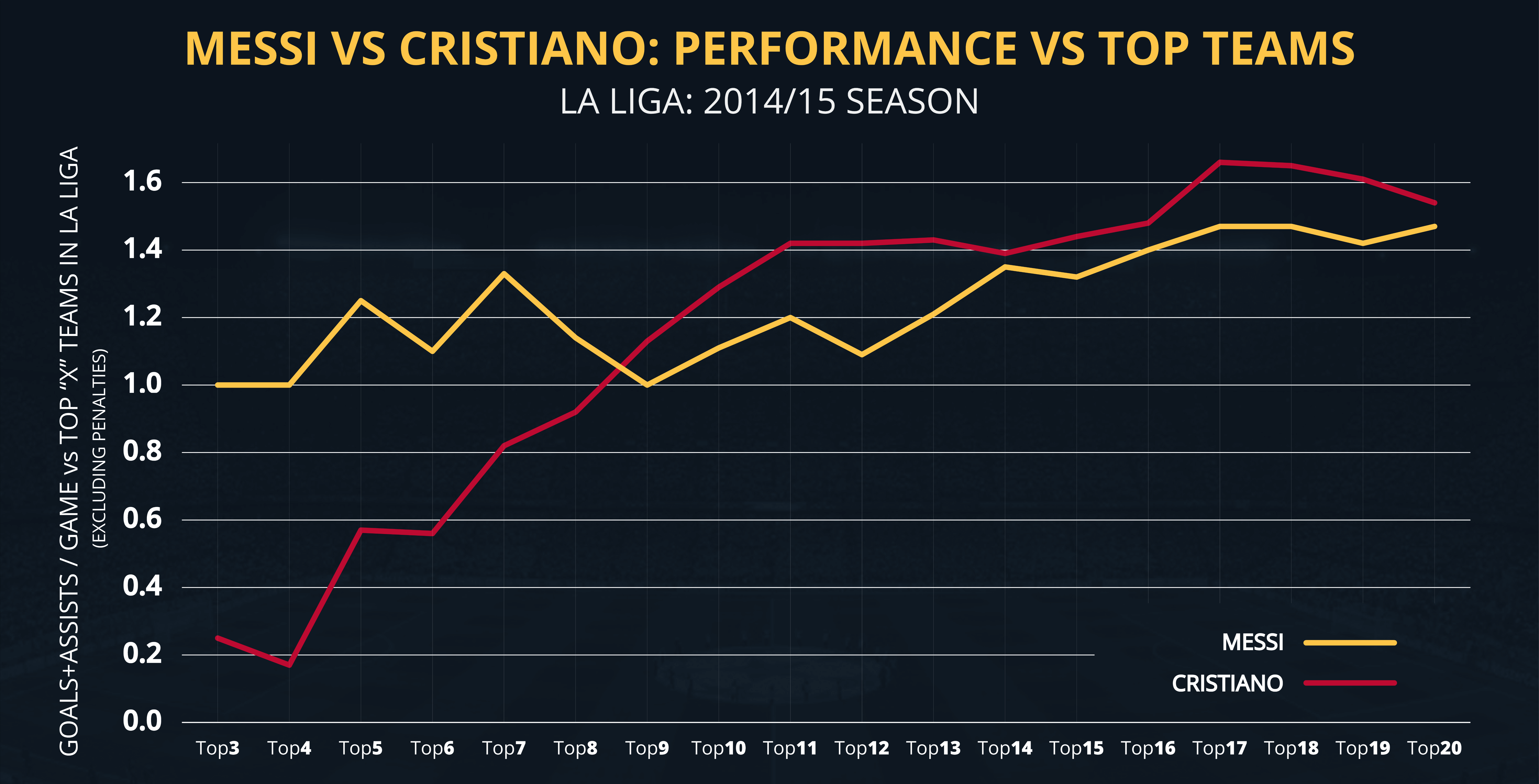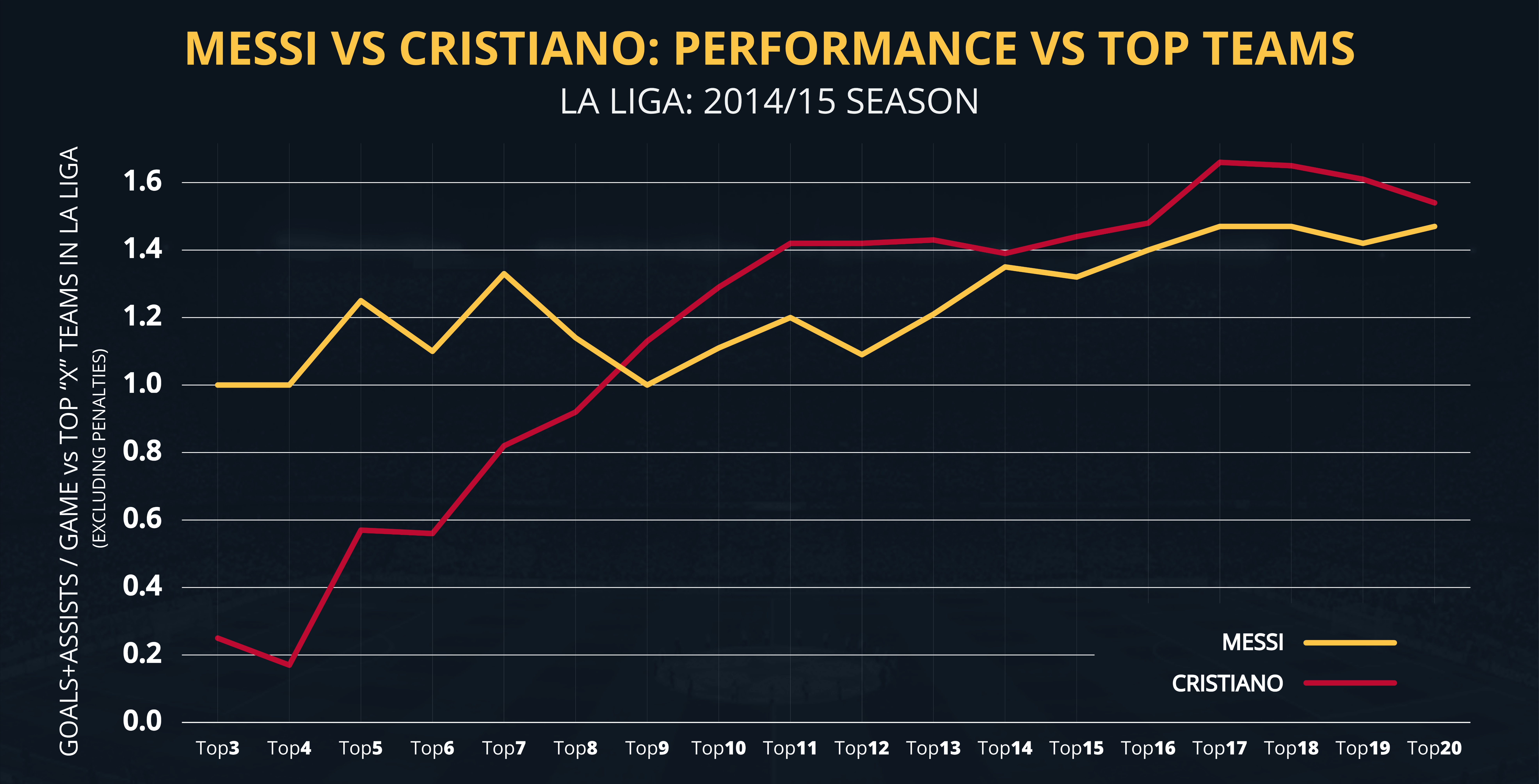 analysis | 2015-06-29
analysis | 2015-06-29
Messi vs Cristiano Ronaldo - What defines a big-game player?
Unraveling who the most influential player is
The "rivalry" between Lionel Messi and Cristiano Ronaldo is a constant debate between football fans, and we all have heard someone claim that one of them is better in matches versus top opposition. But what does it mean to be a big-game player? And is it possible to measure it?
When talking about players that are determinant in decisive matches, you have to keep two things in mind: The first is consistency, a big-game player needs be able to give a good performance regularly in key matches; and the second is perspective, the performance in top matches needs to be compared with their usual displays on most games. The difference in the performances will determine whether the player is indeed delivering at the same level no matter the quality or difficulty of the opposition.
How to measure performance?
An important and often forgotten part of the beautiful game is that it’s impossible to fully measure the performance of football players. The best that can be done is approximating it using this equation, X being the player:

Unfortunately, that is mostly reserved for mathematicians and statisticians.
In the analysis you will find below, the performance measurements will be direct goal contribution, meaning goals plus assists. This is commonly used in football stats but it has several shortcomings. For example, scoring a goal in the last minute when your team is 3-0 up says very little about the player’s overall performance. The same can be said about giving a short pass to your teammate who then dribbles past three players and scores, by certain standards it's considered an assist nonetheless but it doesn’t contribute much.
Nevertheless, most goals are not irrelevant, especially in the big games, and most assists are also key. Therefore, this measure, when used on large data sets, can at least give an indication of the value of the performances.
To further clean the noise regarding this measure, penalty goals are excluded. Penalties are also goals, obviously, but there are three reasons to ignore their contribution:
Scoring a penalty usually has little to do with the quality of the opponent.
Scoring penalties doesn’t say a lot about performance during top matches.
Scoring penalties is statistically easy. The conversion rate of penalties of football players in the last five years is around 75 percent, while the conversion rate during open play inside the small box is around 37 percent. Penalties are essentially twice as easy to convert as the easiest shots from open play, and counting them as half goals would be improper.
The Analysis
In this analysis, the quality of the opponent will be determined by its position in the league standings at the end of the season. But where should we draw the line when we choose the top teams? Top Four?
This question is left to you reader as we examine all possibilities in a continuous graph. To give you a notion, let’s compare how Neymar and Gareth Bale performed in the 2014/15 season as the quality of the opponent varies. To make sure that the two players faced roughly the same opposition, the table below is restricted to La Liga matches.

The way to read the above graph is straightforward. For example, the point (top 6, 0.8) on the blue line says that Neymar averaged 0.8 goals+assists/game by considering his games against clubs that managed to be in the top six of La Liga's table at the end of the 2014/15 season.
There are two remarks about this kind of chart:
- The graph is expected to increase as we move to the right. This is because the average quality of the opponent decreases.
- The graph is expected to fluctuate more on the far left, and flatten toward the far right. The changes reduce because the addition of teams is cumulative. For example, the number of possible games increases by 6.25 percent when we move from the top 17 to the top 18 teams. However, the increase is 25 percent when we move from the top five to the top six teams.
From the chart, we can see that Neymar averaged 0.85 g+a/app in La Liga 2014/15. Bale averaged 0.7 g+a/app. According to the chart, the slight edge Neymar has over Bale is misleading if we include all teams, but the gap between the two widens when we restrict to the games against top teams. In fact, this gap between them triples if we just consider the top eight teams.
Individually, Neymar’s participation drops to 58 percent of his overall contribution when considering the games versus the elite teams (top three). Bale, on the other hand, had a negligible record versus elite teams in La Liga 2014/15, his contribution being at 57 percent of his overall if we consider his games against the top 10 teams. Notice that the graph is cumulative, and his tally against the top 20 teams includes his lacking record against the top 10 teams. We discover that Bale’s contribution against the bottom 10 teams is 2.5 times better than his contribution against the top 10 teams.

Messi vs Cristiano Ronaldo
The chart doesn’t need much comment as the graphic is similar to the one featured and explained above. Messi’s graph is as flat as it gets, resembling a steady performance that isn’t affected by the quality of the opposition. Cristiano’s graph, however, follows an obvious increasing trend as the average quality of the opposition decreases.
Recall the two warnings mentioned at the beginning: Consistency and Perspective. We have discussed perspective when interpreting the chart, but what about consistency? If we are to consider the results of this analysis to be reliable, we should examine a larger set of data as it should truly test their performances in big games.
Let’s consider the same chart, but this time a summary of the last six La Liga seasons, since Cristiano Ronaldo joined Real Madrid. The final league standings of each season was considered separately when computing the numbers.

The interpretation of this chart can also be left to the reader. Regarding penalties and the possible complaints that excluding them could entail, keep in mind that in the last six seasons, both Messi and Cristiano Ronaldo scored only five penalties against clubs that ended the league in the top four, which excludes the possibility of any bias in the analysis.
Conclusion
In yet another performance analysis, Lionel Messi proves to be on a level far above from anyone else. His consistency not only is unique, but has no modern precedents in modern football. Look no further if you are looking for the ultimate big-game player.









